Generic cold emails are a waste of time.
Spraying a templatized message upon every prospect of yours won't do the trick anymore. In fact, your potential customers have learned to tune out of them, thanks to the white noise created by generalized and crappy cold emails.
So what's working? Do people still open cold emails? Do they reply? If yes, what's the best way to write cold emails? Let's find out.
Here are 21 cold email benchmarks you need to know in 2024 to write cold emails that cut through the clutter. We've also added takeaways and pro-level tips so that you'll know exactly how to use these statistics best.
A Pro Guide on How To Write a Cold Email in 2024
Top Cold Email Statistics You Need To Know To Run Successful Cold Email Campaigns
Do Cold Emails Still Work in 2024?
1. 8 Out of 10 Buyers Prefer To Be Contacted by Email.
Cold emails are less intrusive than cold calls. Unlike cold calls, prospects needn't respond in real-time but can do it at their convenience. Cold emails give them more time to learn about your product and weigh their options before coming to a decision. And that's why 8 out of 10 buyers prefer to be contacted by email.
TAKEAWAY: People prefer cold emails. But to succeed, give up on the spray-and-pray approach, research your prospect and personalize your cold emails.
What Is the Average Cold Email Open Rate?
2. Only 23.9% Of Sales Emails Are Opened.
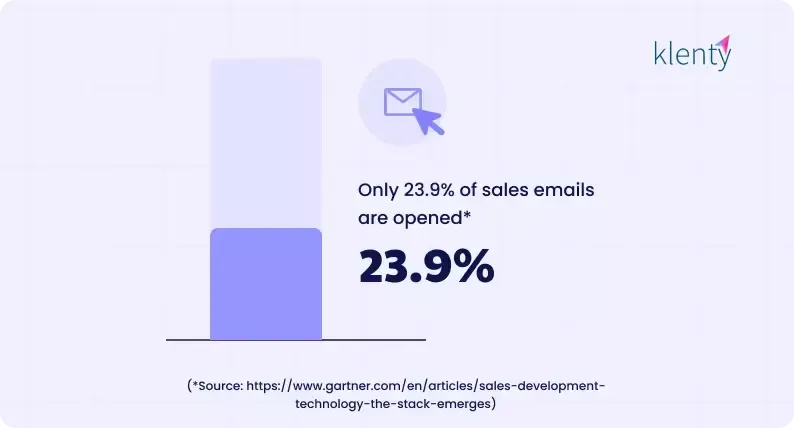
Prospects scan through their inboxes and only open those emails they think are important. Their decision on whether or not to open an email depends on various factors like the sender's name, subject lines, their offer, or the email preview. This is why sales emails only have an open rate of 23.9%.
TAKEAWAY: 77 out of 100 cold emails you send never get opened. However, stack the odds in your favor by writing awesome subject lines, split-testing them, ensuring email deliverability, editing and testing different email previews, and outreaching multiple channels to improve visibility.
What Is the Average Response Rate?
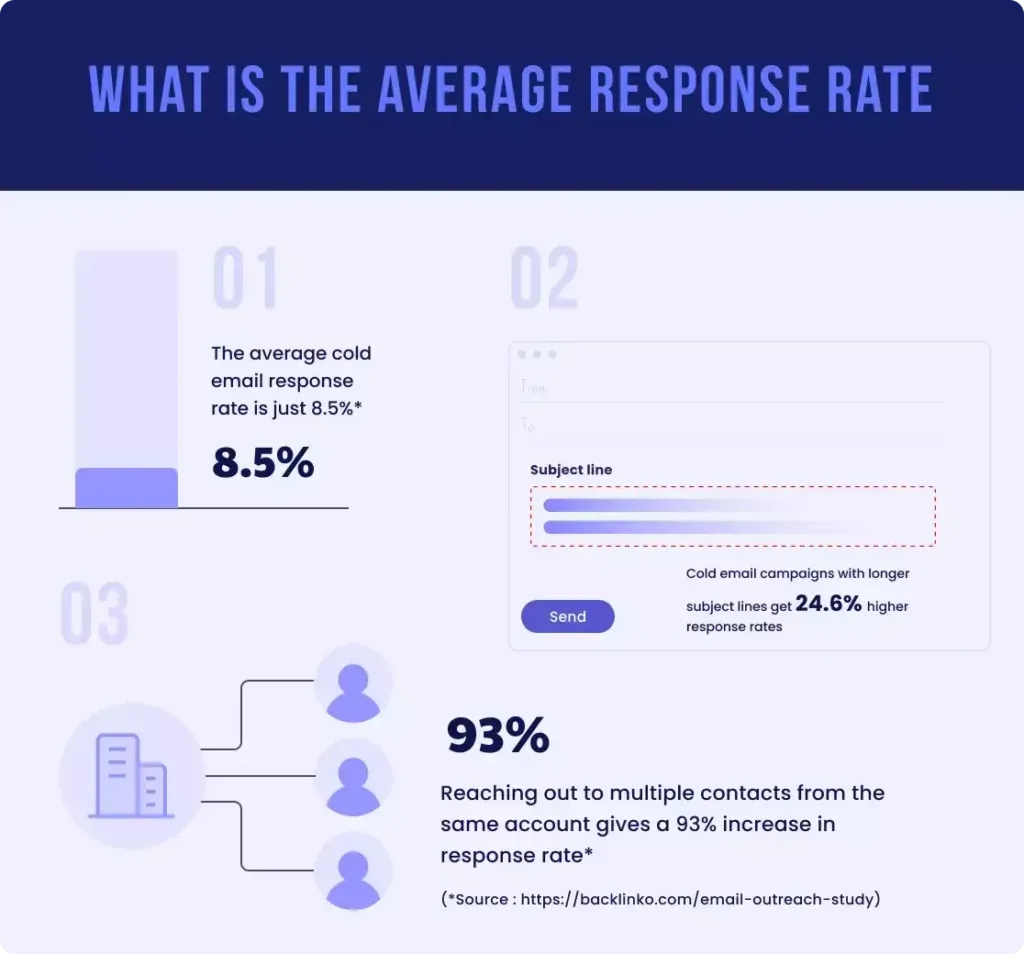
3. The Average Cold Email Response Rate Is Just 8.5%.
If the number of people who open your emails drops, the reply rates drop as well. According to a study by Backlinko, the average cold email reply rate is just 8.5%. However, you can bring your reply rates up if you target the right prospects, personalize emails to the prospect’s interests, and follow up religiously.
Pro Tip: Follow the 30/30/50 rule to gauge the success of your outreach campaign. Aim for a 30% open rate, 30% response rate, and 50% conversion rate.
4. Cold Email Campaigns With Longer Subject Lines Get 24.6% Higher Response Rates.
A longer subject line gives prospects more context about your email. It explains what the email is about and sets their expectations before opening it. This explains why cold email subject lines with around 36-50 characters get 24.6% higher response rates.
TAKEAWAY: When you give enough context in your email subject lines, prospects know what the email copy is about. Thus, unlike clickbait subject lines, it won't leave your prospects frustrated thinking you tricked them into opening the email. That said, it doesn’t mean you should consider it the gospel truth. Keep testing short and long subject lines, to find out what works best for you. Here’s more on writing great subject lines.
5. Reaching Out to Multiple Contacts From the Same Account Gives a 93% Increase in Response Rate.
With many businesses losing deals because of decision-makers switching jobs, reaching out to multiple prospects from the same company is the need of the hour. This is true in the case of cold emailing too. The research found a 93% increase in response rates when a multi-threaded cold emailing approach is followed.
Pro Tip: Account-based selling or reaching out to multiple stakeholders from a single company is an effective sales strategy to follow in 2024. To know more about it, click here.
Best Email Subject Line Statistics
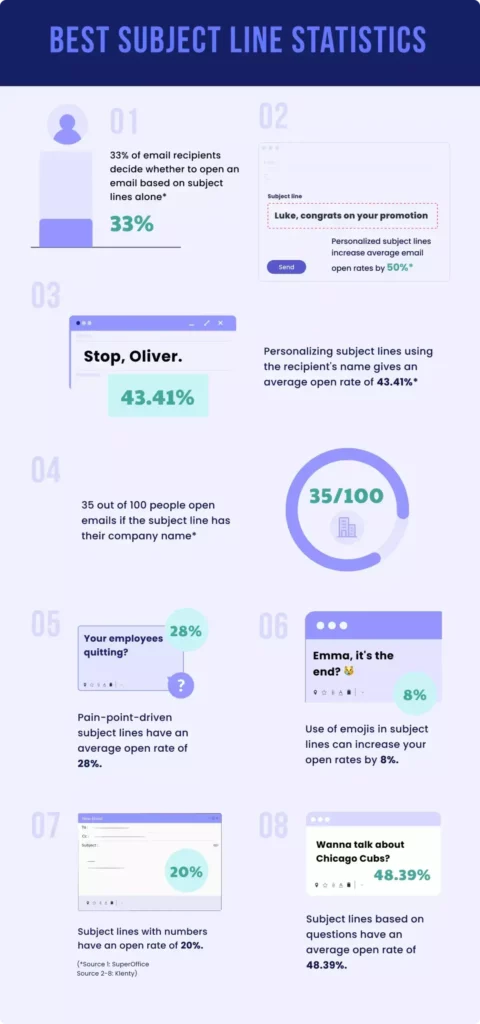
6. 33% Of Email Recipients Decide Whether To Open an Email Based on Subject Lines Alone.
Subject lines are the first thing your prospect looks into when they receive emails from an unknown sender. In fact, 33% of recipients use subject lines as a deciding factor to weed out emails, reports a study by Super Office. So, if your subject lines look generic or spammy, they won't bother to open the email, let alone read it.
TAKEAWAY: Use various subject line techniques to make your subject lines relevant to the readers. For example, talk about pain points, use humor, or even trigger FOMO.
7. Personalized Subject Lines Increase Average Email Open Rates by 50%.
When you use subject lines that are related to your prospect in one way or another, they can't help but notice it. These subject lines scream, "hey, this is for you" to your prospects. And that's why personalized subject lines have an open rate of 35.69%, almost double the open rates of non-personalized ones(16.67%).
Pro Tip: Use the prospect's name, company name, mutual connections, or interests to tailor subject lines.
8. Personalizing Subject Lines Using the Recipient’s Name Gives an Average Open Rate of 43.41%.
Using a prospect's name in the subject line snares their interest and makes them wonder, "How is this email relevant to me?". And since there's only one way to find out, they open your email. And that explains why emails with name personalized subject lines have an average open rate of 43.41%.
TAKEAWAY: Name personalization works, but it isn't always enough for a successful outreach campaign. For better results, combine it with other personalization techniques.
For example, {prospect name}+ {pain point}
9. 35 Out of 100 People Open Emails if the Subject Line Has Their Company Name.
"It is work-related and might be important." That's the reaction you elicit in your prospects through a subject line personalized with their company name. This FOMO makes them open your cold emails.
PRO TIP: Using subject lines that create urgency is another way to trigger FOMO.
For example, Final Chance to Solve {pain point}
10. Pain-Point-Driven Subject Lines Have an Average Open Rate of 28%.
Your prospects can't ignore when you talk about that one thing that's giving them a hard time. For example, when you mention the difficulty of manually keeping tabs on prospects in the subject line of an email sent to an SDR, they can't help but notice your email.
In fact, a recent study we ran at Klenty confirmed that pain point-driven subject lines work and have an open rate of 28%.
Pro Tip: A/B test your cold email subject lines using a cold email software.
11. Use of Emojis in Subject Lines Can Increase Your Open Rates by 8%.
Emojis bring in some color to an otherwise monochrome email inbox. In other words, they help you catch your prospect’s eye easily. Emojis also help you convey something in fewer words with more vigor. That’s why subject lines with emojis have an 8% higher open rate.
TAKEAWAY: Know your audience before you use emojis in subject lines. Also, use it only where relevant, overuse of emojis put you at risk of triggering spam filters and tampering with the deliverability of your emails.
12. Subject Lines With Numbers Have an Open Rate of 20%.
Numbers are a great way to catch your prospect's attention, especially when they're accustomed to scanning their inboxes. A study we did at Klenty confirms this: subject lines with numbers had an open rate of 20%.
TAKEAWAY: Numbers in subject lines help prospects know what to expect from your cold emails. For example, the subject line, {prospect name}, 1 question conveys what the email is about.
13. Subject Lines Based on Questions Have an Average Open Rate of 48.39%.
Humans are curious beings. When asked a question, they get the urge to find answers. The same thing happens when you ask questions through your email subject lines. Your prospects get the itch for an answer and open your emails. This is why subject lines that pose a question have an average open rate of 48.39%.
TAKEAWAY: Find out your prospect’s goals, pain points, or challenges and frame questions about them in your subject lines. Want to see some examples? Head to our blog on cold email subject lines.
Data-Backed CTA Statistics (& Top Strategies)
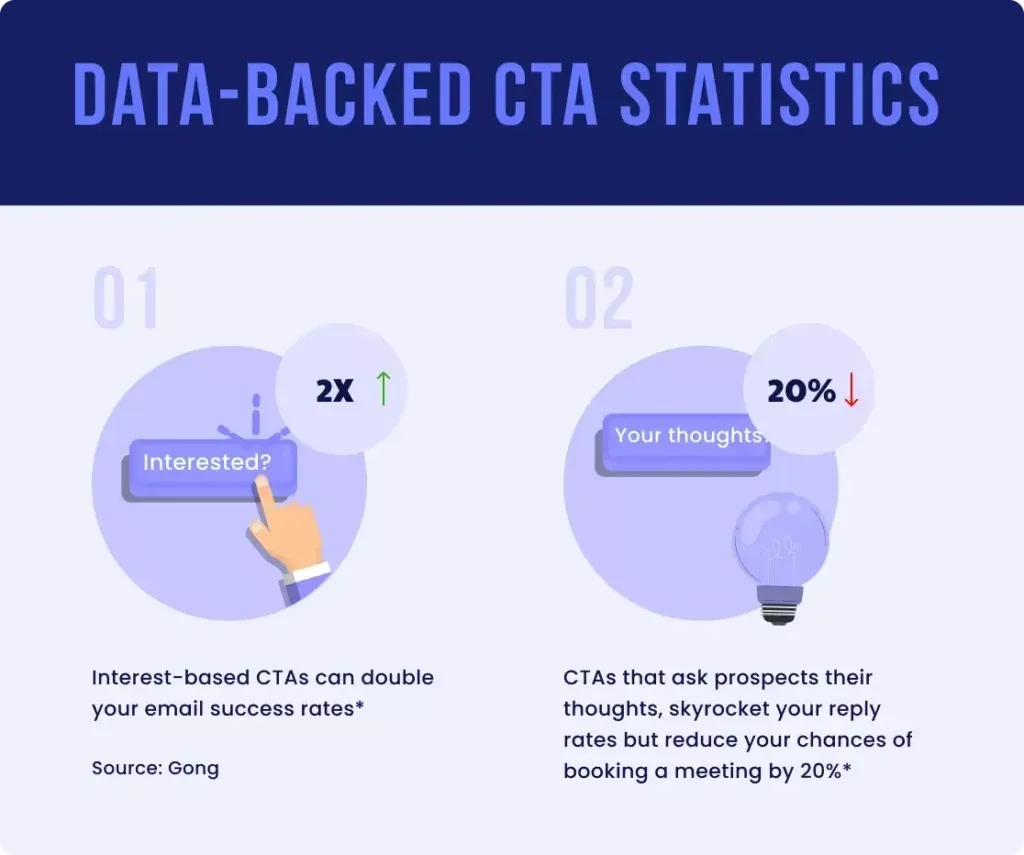
14. Interest-Based Ctas Can Double Your Email Success Rates.
"Interest CTA" is a type of call to action that hinges on their interest in finding out more about what you had written about in your cold email. So, instead of cornering them into a meeting, it comes off as if you’re trying to build a relationship with your prospects.
For example: "Are you interested to know more about this?"
An original study of the Revenue intelligence platform, Gong, proved that "interest CTAs" has a success rate of 30%, double the success rates of any other type of CTAs.
TAKEAWAY: Don't expect to get meetings booked with a single cold email. Build trust and rapport with your prospects before you make the big ask.
15. CTAs That Ask Prospects Their Thoughts Skyrocket Your Reply Rates but Reduce Your Chances of Booking a Meeting by 20%.
"Let me know your thoughts" seems like a great way to end a cold email. But research says otherwise. As per Gong’s latest study, asking prospects for their thoughts boosts your reply rates but reduces your chances of booking a meeting by 20%.
TAKEAWAY: Don't ask for your prospects' thoughts, use the interest-based CTA instead.
Follow-up Statistics

16. Sending a First and Second Follow-up Email Increases Your Chances of Getting a Reply by 21% And 25%, Respectively.
Sending sales follow-up emails is inevitable for a successful cold email outreach. In fact, cold email expert Alex Berman testifies that most of his cold emails never got a reply until he followed up. Sending the first follow-up boosts your chance of getting a reply by 21% and a second one by 25%.
PRO TIP: Longer follow-up emails increase your chances of booking a meeting by 15x. Aim for around 150 words, and always reiterate the content of your first email in your follow-ups. Never send a follow-up that doesn’t have context. Your prospects might be getting bombarded by hundreds of emails, which could have easily buried your first email. You need to remind them of who you are and why you’re emailing once again in your follow-up.
When Is the Best Time To Send Cold Emails?
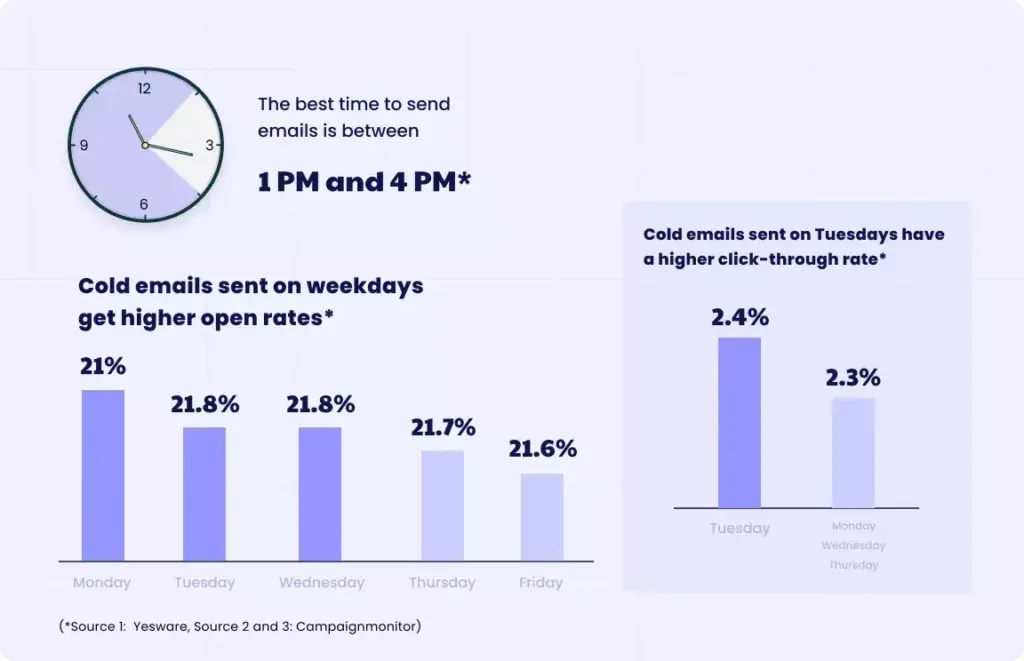
17. The Best Time To Send Emails Is Between 1 PM and 4 PM.
According to a study conducted by Yesware, the best time to send cold emails is between 1 PM and 4 PM. 1 PM falls directly after lunch breaks, so people are probably checking their inboxes when they log in again. Similarly, 4 PM falls during tea breaks or closer to log-out times, and they are probably taking quick peeks into their inboxes.
Generally, the time window between 1 PM- 4 PM works as most people will be at work during these hours.
TAKEAWAY: For starters, send out cold emails during the time window between 1 PM and 4 PM. But after a while, look into your campaign analytics and find the best time for your target audience.
18. Cold Emails Sent on Weekdays Get Higher Open Rates.
The best day to send cold emails is Monday (22%), followed by Tuesday (21.8%), Wednesday(21.8%) Thursday(21.7%), and Friday(21.6%). In terms of click-through rates, Tuesday tops the list with 2.4%, closely followed by Monday, Wednesday, and Thursday with 2.3%.
TAKEAWAY: Don't send cold emails on weekends. For best results, schedule them for Monday or Tuesday between 1-4 PM.
What Should You Write in Cold Emails? (Data-Backed Tips)
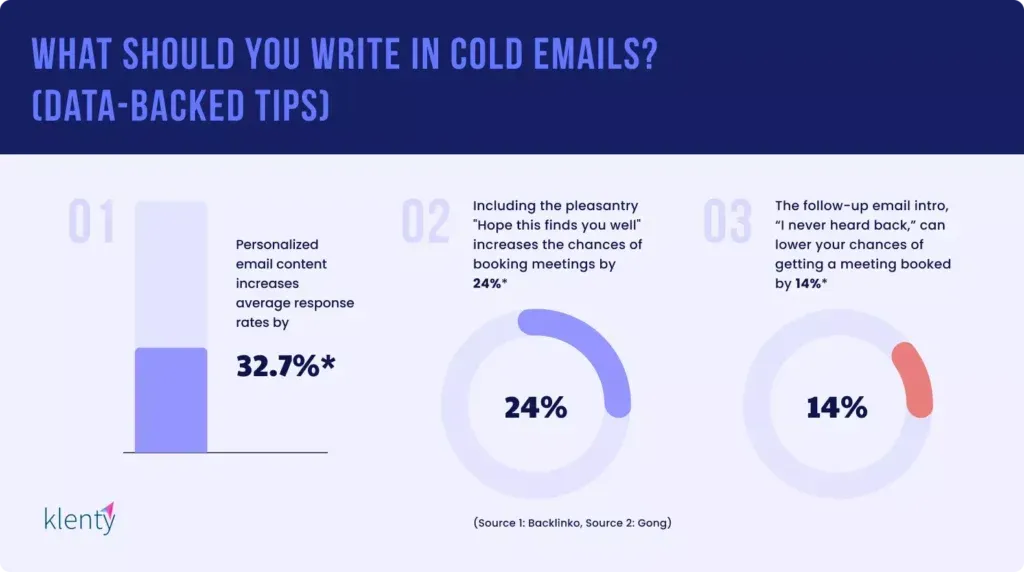
19. Personalized Email Content Increases Average Response Rates by 32.7%.
When you tailor your email body according to your prospect's pain points, needs, challenges, or goals, your cold emails stand out from the clutter. In fact, well-personalized email copy increases response rates by 32.7%, confirms Backlinko. This is because personalized emails assure your prospects that you can be trusted and relied upon.
Pro Tip: Just like subject lines, you can personalize your email content using factors like trigger events, humor, pain-point, etc. However, if you are sending cold emails to over 200 people daily, manually personalizing each of them is impossible. So, use a cold email software to do this.
20. Including the Pleasantry “Hope This Finds You Well” Increases the Chances of Booking Meetings by 24%.
Sounds unbelievable? But the research by Gong says otherwise. Pleasantries, though cliched, make your emails appear less blunt and more cordial. This is important, especially when you are cold emailing, as sounding impolite is the last thing you want.
TAKEAWAY: "Hope this finds you well" works. But if everyone starts using it, it no longer becomes pattern interrupting. So, give your pleasantry a spin by personalizing it with something relevant to the prospect. Here's an example: "Hey Zac, I hope all is well, especially after what happened with the Cubs. As a fellow Cubs fan, I can only hope one thing, May they overcome their 9-game losing streak soon."
21. The Follow-up Email Intro, “I Never Heard Back,” Can Lower Your Chances of Getting a Meeting Booked by 14%.
Your prospects are under no obligation to respond to your cold emails. So, when you follow up making them guilty of not responding, you give them yet another reason to ignore you. This explains why the follow-up email intro, “I never heard back” can lower your chances of getting a meeting booked by 14%.
TAKEAWAY: Never try to guilt-trip your email recipients into responding. Instead, use a joke or a pattern-interrupting introduction for your follow-up. To get pattern-interrupting prompts, head to our blog.
Conclusion
Before you start chalking out your next cold email strategy, here's a disclaimer: take every statistic with a pinch of salt! While these findings are data-driven, following them to a tee won't yield similar results.
This is because the success of your cold emails depends on a lot of other factors like the industry you belong to, target audience, etc. Hence, the best way is to compare these statistics with your previous campaign results.
So, if your older campaigns have given better open rates during weekends, even if we claim otherwise, continue sending them on weekends.

